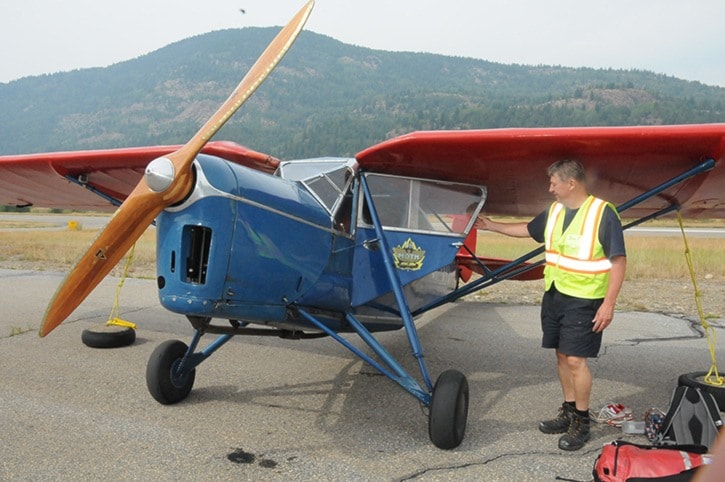An iconic symbol of Trail history made a brief stopover at the city’s airport late Thursday afternoon, much to the delight of onlookers and staff.
Ben Cox and his partner Anne Marie Liszczyk, both aviation aficionados from England, flew a 1934 Puss Moth onto the Trail airstrip in a mission to return the aircraft home for the first time in 50-plus years.
The de Havilland DH Puss Moth, previously owned by the Consolidated Mining and Smelting Company of Canada Ltd. (CM & S, later Cominco Ltd.), was a modern wonder in the 1930s when the company used the three-seater for mineral exploration in the country’s northern regions.
The plane was bought by a gentleman from Spokane in 1958, and since that time, it’s been housed south of the border.
After Cox became the Puss Moth’s owner a few years ago, the U.K. duo have booked summer vacations together to travel the Pacific Northwest and Alberta via the light utility aircraft.
“I’d known about it (Puss Moth) for 20 odd years,” said Cox. “I became friends with the previous owner who’s gotten elderly and wanted to sell it a couple of years ago. So I bought it, and this year we wanted to see where it lived.”
When the couple first landed at the Trail airport, Liszczyk felt uncertain about her surroundings – but her apprehension was brief.
“I wasn’t sure where we were, so we went around to the terminal right after we landed,” she explained. “An elderly gentleman, inside, was nudging his wife, saying “Oh my gosh look, there’s a Puss Moth, there’s a Puss Moth,” Liszczyk laughed. “We were only here for a short while before someone recognized it.”
After parking the aircraft off the runway for the night, the couple returned to the airport Friday morning with plans to fly back to Spokane by noon.
Before that happened, a handful of airport workers, Pacific Coastal Airlines employees and a few locals, were treated to an up-close-and-personal look at the historic airplane and a chat with its new owners.
“I’ve done a lot of work to make it useful for trips like this,” said Cox. “It’s pretty conventional to fly and very capable because it carries a lot of fuel, has lots of room for bags and can go a long way.”
The de Havilland DH.80A Puss Moth is a British three-seater high-wing monoplane designed and built by the de Havilland Aircraft Company between 1929 and 1933.
It flew at a speed approaching 200 kilometres per hour, making it one of the highest-performance private aircraft of its era.
See PUSS, Page 3
The CM & S’s use of airplanes for early exploration of the north was unique in the mining industry and played a prominent role in advancing the establishment of working mines in what was a very remote part of the industry in Canada, said Jamie Forbes from the Trail Historical Society.
The company’s bush pilots were brave and adventurous and can be described as true pioneers in Canada’s aviation history.
“This is national aviation history not just part Trail history,” said Forbes. “It’s part of our Canadian mining history and there’s none left that I know of. It’s important to us and to our country.”
